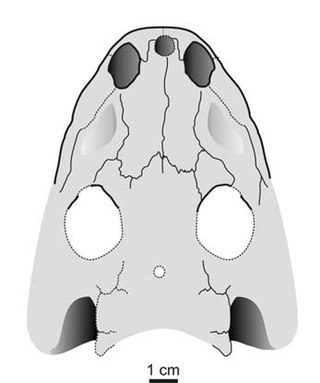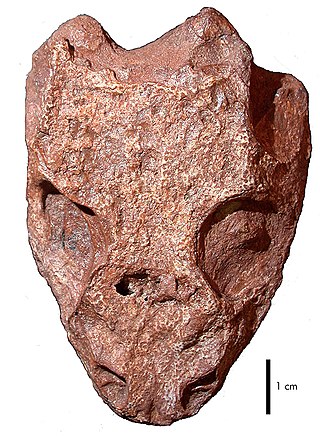
Adelospondyli is an order of elongated, presumably aquatic, Carboniferous amphibians. They have a robust skull roofed with solid bone, and orbits located towards the front of the skull. The limbs were almost certainly absent, although some historical sources reported them to be present. Despite the likely absence of limbs, adelospondyls retained a large part of the bony shoulder girdle. Adelospondyls have been assigned to a variety of groups in the past. They have traditionally been seen as members of the subclass Lepospondyli, related to other unusual early tetrapods such as "microsaurs", "nectrideans", and aïstopods. Analyses such as Ruta & Coates (2007) have offered an alternate classification scheme, arguing that adelospondyls were actually far removed from other lepospondyls, instead being stem-tetrapod stegocephalians closely related to the family Colosteidae.

Dissorophidae is an extinct family of medium-sized temnospondyls that flourished during the late Carboniferous and early Permian periods. The clade is known almost exclusively from North America.

Varanops is an extinct genus of Early Permian varanopid known from Texas and Oklahoma of the United States. It was first named by Samuel Wendell Williston in 1911 as a second species of Varanosaurus, Varanosaurus brevirostris. In 1914, Samuel W. Williston reassigned it to its own genus and the type species is Varanops brevirostris.

Platyhystrix is an extinct temnospondyl amphibian with a distinctive sail along its back, similar to the unrelated synapsids, Dimetrodon and Edaphosaurus. It lived during the boundary between the latest Carboniferous and earliest Permian periods throughout what is now known as the Four Corners, Texas, and Kansas about 300 million years ago.
Casea is a genus of herbivorous caseid synapsids that lived during the late Lower Permian (Kungurian) in what is now Texas, United States. The genus is only represented by its type species, Casea broilii, named by Samuel Wendell Williston in 1910. The species is represented by a skull associated with a skeleton, a second skull, a partial skull with a better preserved dentition than that of the preceding skulls, and several incomplete postcranial skeletons. Three other Casea species were later erected, but these are considered today to be invalid or belonging to different genera. Casea was a small animal with a length of about 1.20 m and a weight of around 20 kg.

Limnoscelis was a genus of large diadectomorph tetrapods from the Late Carboniferous of western North America. It includes two species: the type species Limnoscelis paludis from New Mexico, and Limnoscelis dynatis from Colorado, both of which are thought to have lived concurrently. No specimens of Limnoscelis are known from outside of North America. Limnoscelis was carnivorous, and likely semiaquatic, though it may have spent a significant portion of its life on land. Limnoscelis had a combination of derived amphibian and primitive reptilian features, and its placement relative to Amniota has significant implications regarding the origins of the first amniotes.

Aspidosaurus is an extinct genus of dissorophoid temnospondyl within the family Dissorophidae.

Broiliellus is an extinct genus of dissorophoid temnospondyl within the family Dissorophidae. Broiliellus is most closely related to the genus Dissorophus, and both have been placed in the subfamily Dissorophinae. Broiliellus is known from five species from the Early Permian: the type species is Broiliellus texensis, and the other species are Broiliellus brevis,Broiliellus olsoni, Broiliellus arroyoensis, and Broiliellus reiszi. An additional species, Broiliellus novomexicanus, which was originally named Aspidosaurus novomexicanus, is now thought to fall outside the genus as a member of the subfamily Eucacopinae.

Batropetes is an extinct genus of brachystelechid recumbirostran "microsaur". Batropetes lived during the Sakmarian stage of the Early Permian. Fossils attributable to the type species B. fritschi have been collected from the town of Freital in Saxony, Germany, near the city of Dresden. Additional material has been found from the Saar-Nahe Basin in southwestern Germany and has been assigned to three additional species: B. niederkirchensis, B. palatinus, and B. appelensis.

Conjunctio is an extinct genus of dissorophid temnospondyl amphibian from the early Permian of New Mexico. The type species, Conjunctio multidens, was named by paleontologist Robert L. Carroll in 1964.

Dissorophus (DI-soh-ROH-fus) is an extinct genus of temnospondyl amphibian that lived during the Early Permian Period about 273 million years ago. Its fossils have been found in Texas and in Oklahoma in North America. Its heavy armor and robust build indicate Dissorophus was active on land, similar to other members of the clade Dissorophidae that are known from the Late Carboniferous to the Early Permian periods. Dissorphus is distinguished by its small body size, disproportionately large head and short trunk.
Hapsidopareion is an extinct genus of microsaur belonging to the family Hapsidopareiidae. Fossils have been found in the early Permian of Oklahoma.
Llistrofus is an extinct genus of early Permian microsaur within the family Hapsidopareiidae that is known from Oklahoma.
Pariotichus is an extinct genus of gymnarthrid microsaurs from the early Permian of Texas.

Trimerorhachis is an extinct genus of dvinosaurian temnospondyl within the family Trimerorhachidae. It is known from the Early Permian of the southwestern United States, with most fossil specimens having been found in the Texas Red Beds. The type species of Trimerorhachis, T. insignis, was named by American paleontologist Edward Drinker Cope in 1878. Cope named a second species from Texas, T. mesops, in 1896. The species T. rogersi and T. greggi are also from Texas, and the species T. sandovalensis is from New Mexico.
Trihecaton is an extinct genus of microsaur from the Late Pennsylvanian of Colorado. Known from a single species, Trihecaton howardinus, this genus is distinctive compared to other microsaurs due to possessing a number of plesiomorphic ("primitive") features relative to the rest of the group. These include large intercentra, folded enamel, and a large coronoid process of the jaw. Its classification is controversial due to combining a long body with strong limbs, features which typically are not present at the same time in other microsaurs. Due to its distinctiveness, Trihecaton has been given its own monospecific family, Trihecatontidae.

Brachystelechidae is an extinct family of Early Permian microsaurs. The family was first named by Robert L. Carroll and Pamela Gaskill in 1978, with the only member being Brachystelechus fritschi. Brachystelechus fritschi has since been reassigned to the genus Batropetes. Genera assigned to the family include: Batropetes, from Germany; Carrolla, from Texas; Quasicaecilia, also from Texas; Diabloroter, from the Mazon Creek lagerstätte of Illinois; and Bromerpeton from the Tambach Formation of Germany.

Ostodolepidae, also spelled Ostodolepididae, is an extinct family of Early Permian tetrapods. Initially they were considered microsaurs, but later were assigned to the group Recumbirostra. Ostodolepids were relatively large, reaching lengths of up to 2 feet (61 cm), terrestrial, and presumably fossorial. Ostodolepid remains have been found from Early Permian beds in Texas, Oklahoma, and Germany.

Nannaroter is an extinct genus of Recumbirostran tetrapod within the family Ostodolepidae.

Hapsidopareiidae is an extinct family of microsaurs. Hapsidopareiids are known from the Early Permian of the United States and possibly Germany and the Czech Republic.
















